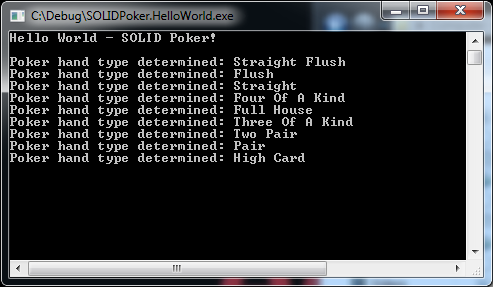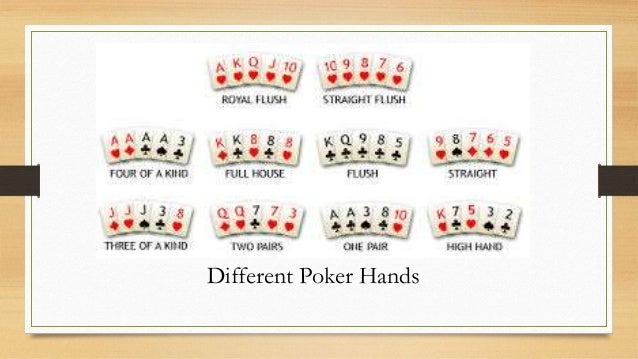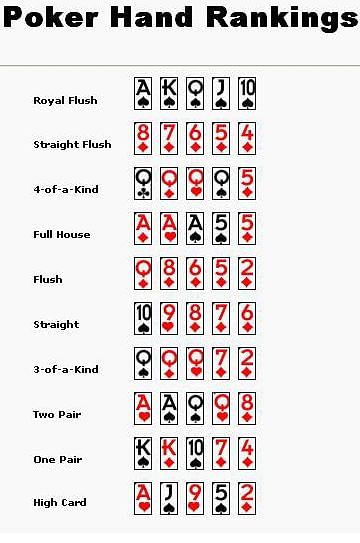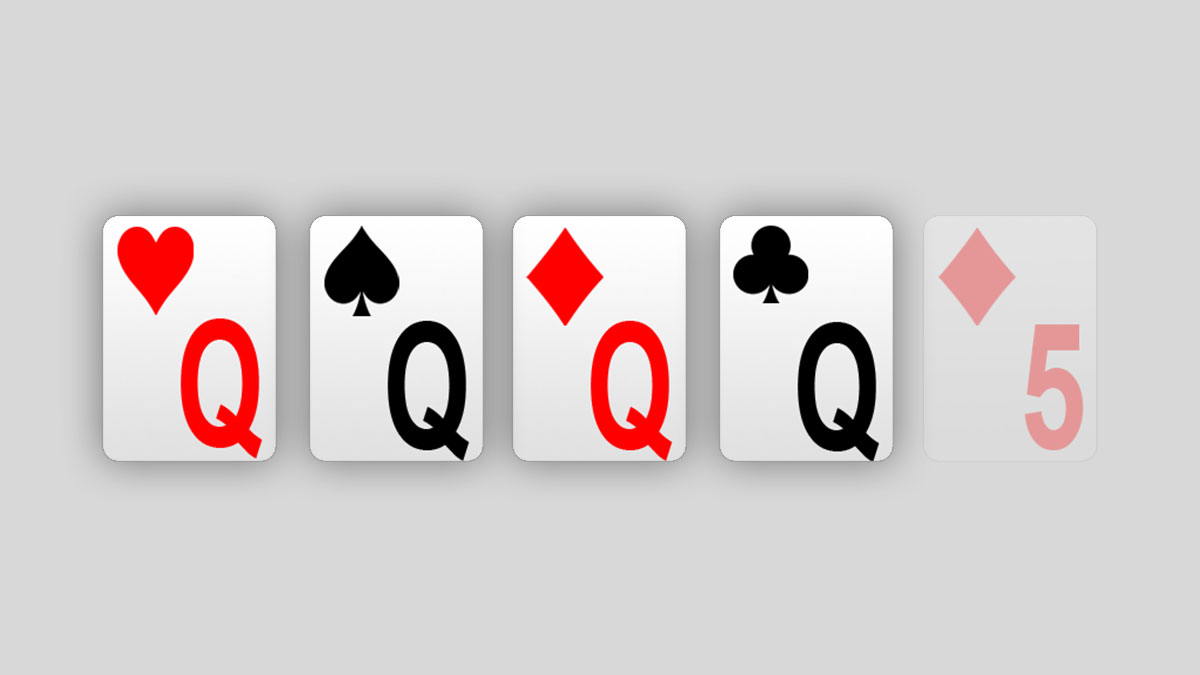Poker Types Of Hands
Posted : admin On 3/22/2022- Poker Types Of Hands Sanitizer
- Different Types Of Poker Hands
- Poker Types Of Hands Clipart
- Types Of Hands In Poker
Types of Poker Hands #1 Royal Flush. The most difficult hand to come by in poker, the royal flush only has a 0.000154% probability of. #2 Straight Flush. This hand is pretty much the same as a royal flush. The only difference is that it has a king. #3 Four of a Kind. Made up of four.
- Four of a Kind is an exceptionally strong poker hand and ranks third in the official poker hand rankings. As the name suggests, it is made of four cards of the same rank with an additional card, which is entirely irrelevant. The best Four of a Kind poker hand is A A A A x, which beats all other 4 of a Kind and lower hands in poker.
- Six Types Of Poker Explained 1. Texas Hold’em Poker. Since a very long time ago, this was, and still is the most popular variation of the game. Daniel Negreanu If playback doesn't begin shortly, try restarting your device. Videos you watch may be added. Seven Card Stud.
- The highest valued poker hand and one that you are going to want to be dealt out to you when your fellow players all have high valued hands is the Royal Flush hand. The hand is simply made up of a set of five cards which are the Ace, King, Queen, Jack and Ten cards, and to be a Royal Flush they must all be in the same suit.
- Considered as poker hands, the back hand must be better than the middle hand, and the middle hand must be better than the front hand. The standard poker ranking is used - so the hand types from high to low are: royal flush, straight flush, four of a kind, full house, flush, straight, three of a kind, two pairs, one pair, high card (see the page on ranking of poker hands ).
This page is based partly on information from Ka Lun, Anthony Horsley Sr, Don Smolen, Richard Dewhirst, Alan Ho, Brandon Bahti and several anonymous correspondents.
Introduction
This Chinese gambling game is popular in Hong Kong and parts of Southeast Asia and is also played to some extent in the USA. It is known by several different names.
- In Cantonese it is called Sap Sam Cheung (十三張), which means 13 cards, and in Vietnamese it is known by the similar name Xập Xám Chướng.
- In Chinese, it is also sometimes called Luosong Pai Jiu (羅宋牌九), which I think means Russian Pai Gow. The game is indeed distantly related to Pai Gow.
- In the USA it is often known as Chinese Poker or sometimes Russian Poker, but note that some people also use the name Chinese Poker to refer to the climbing game Big Two. In Hawaii it is called Pepito.
- In the Phillipines it is known as Pusoy, again not to be confused with Pusoy Dos, which is Big Two. Another name sometimes used is Good, Better, Best, referring to the three hands of a player.
The aim is to arrange your 13 cards into three poker hands - two of five cards and one of three cards - which will beat the corresponding poker hands made by the other players.
A recent development is Open Face Chinese Poker, in which after the first five cards, hands are built face up one card at a time.
Players, Cards, Stakes and Deal
There are four players, each playing for themselves. A standard 52 card pack is used.
Before playing it is necessary to agree on a stake. Below I will describe the payments in terms of units; one unit can be worth whatever the players agree in advance - $1, $10, $100, etc.
The cards are shuffled, cut and dealt out singly: 13 cards to each player.
Arrangement of cards
Each player must divide their 13 cards into a 'back' hand of 5 cards, a 'middle' hand of 5 cards and a 'front' hand of 3 cards. Considered as poker hands, the back hand must be better than the middle hand, and the middle hand must be better than the front hand. The standard poker ranking is used - so the hand types from high to low are: royal flush, straight flush, four of a kind, full house, flush, straight, three of a kind, two pairs, one pair, high card (see the page on ranking of poker hands). There are no wild cards.

Since the front hand has only 3 cards, only three hand types are possible: three of a kind; one pair; high card. There is no value in having a front hand with three consecutive cards or three cards of the same suit: 'straights' or 'flushes' in the front hand do not count.
Players place their three hands face down in front of them, the front hand nearest the centre of the table and the back hand nearest themselves.
Showdown and Scoring
When everyone is ready, all the players expose their three hands and each pair of players compares the corresponding hands. In the simplest system of payments, you win one unit for each corresponding hand of another player that you beat and lose one for unit each hand that beats you. When the hands are equal you neither win nor lose. Here is an example:
The result would be as follows:
| Players | front winner | middle winner | back winner | North | East | South | West |
|---|---|---|---|---|---|---|---|
| North v East | North | North | North | +3 | -3 | ||
| North v South | South | South | North | -1 | +1 | ||
| North v West | North | North | West | +1 | -1 | ||
| East v South | South | South | East | -1 | +1 | ||
| East v West | East | West | West | -1 | +1 | ||
| South v West | South | South | West | +1 | -1 | ||
| Total | +3 | -5 | +3 | -1 |
Notice that although West's back hand is the overall best hand (aces full), West loses on balance because of the weaker middle and front hands. East could have done slightly less badly by putting the sevens in the middle hand, which would then have beaten West. Notice also that it is not legal for East to put the jacks in the front hand, because it would then not be possible to make a middle hand that was better and a back hand that was better still from the remaining ten cards.
Special Hands
It is possible to play using just the payments described above. However, many players add two further features to the stakes: increased payments for certain hands, and some special 13-card hands that win automatically. If you are playing with these it is important to agree in advance exactly which ones are allowed and how much each is worth.
A typical scale of increased payments is as follows:
- If you win the front hand with three of a kind, you receive 3 units instead of 1 for that hand.
- If you win the middle hand with a full house, you receive 2 units instead of 1 for that hand.
- If you win the back (or middle) hand with 4 of a kind, you receive 4 units instead of 1.
- If you win the back (or middle) hand with a royal flush or straight flush you win 5 units instead of 1.
These bonuses only count for you for hands that you win. For example if A and B each have a 3 of a kind in front, but B's is higher, A will pay B 3 units for it. A's 3 of a kind will still count against the other players if it wins.
Example:A has 6-6-6, 4-4-4-9-9, K-K-K-8-8 and B has Q-Q-7, J-J-J-2-2, 5-5-5-5-A. A wins 3 for the front hand, but B wins 2 for the middle and 4 for the back, so altogether A pays 3 units to B.
When special hands are allowed, the following 13-card hands win automatically against any ordinary hand, if declared before the hands are exposed. When two special hands come up against each other, the higher wins the full specified amount and the lower loses its value (though it can still win against the other players). After the special hands have been dealt with, the remaining players expose their cards and settle up among themselves in the normal way. A typical schedule of special hands, in ascending order, is:
- Six pairs: a hand with six pairs and one odd card. When two players have six pair hands, compare the highest pair; if the highest pairs are equal compare the second highest pair, and so on. Win 3 units.
- Three straights: the back and middle hands are five card straights and the front hand is a three card straight (i.e. three cards of consecutive rank). If two players have three straights, compare the highest (back) straights first, then if these are equal the middle straights, and finally, if all else is equal, the front straight. Win 3 units.
- Three flushes: the back and middle hands are flushes, and the front hand is a three-card flush (three cards of one suit). If two players have this, the player with the better back hand wins; if tied the better middle hand; if those are also tied, the better front hand. Win 3 units.
- Complete straight: the hand has one card of each rank: A-2-3-4-5-6-7-8-9-10-J-Q-K. Suits can be mixed. If two players have this, they are tied. Win 13 units.
A player who has a special hand can choose not to declare it, but instead to set three hands of 5, 5 and 3 cards in the normal way. This loses the right to an automatic win, but it may occasionally be possible to win more units in the normal settlement, when extra payments can be won.
Variations
There seem to be numerous variations in the way the payments are organised. Here are the ones I have so far discovered.
- Three of a kind in the front hand: 2 extra units
- Full house in the middle hand: 1 extra unit
- Four of a kind in the back or middle hand: 3 extra units
- Straight or royal flush in the back or middle hand: 4 extra units
This variation is often combined with the overall point variation above.
- Three of a kind in the front hand: 2 extra units
- Full house in the middle hand: 2 extra units
- Four of a kind in the back hand: 4 extra units
- Four of a kind in the middle hand: 6 extra units
- Straight or royal flush in the back hand: 6 extra units
- Straight or royal flush in the middle hand: 8 extra units
The special hands, in ascending order, are:
- Three flushes: 3 units
- Three straights: 4 units
- Six and a half pairs: 4 units
- Five pairs and one three of a kind: 5 units
- Four threes of a kind and an odd card: 6 units
- All cards are the same colour: 10 points
- Small: all cards are 2, 3, 4, 5, 6, 7, 8: 10 points
- Big: all cards are 8, 9, 10, J, Q, K, A: 10 points
- Three fours of a kind and one odd card: 16 units
- Three straight flushes: 18 units
- All 12 picture cards plus any 13th card: 18 units
- All thirteen cards of one suit: 26 units
A special hand, if declared before the cards are exposed, beats any normal hand and wins the number of units specified in the table (a player wins from the bank, or the bank wins from all players). If the bank and a player both have special hands, the holder of the higher scoring hand wins the difference between their values.
- Three of a kind in front: 3 units instead of 1
- Full house in the middle: 2 units instead of 1
- Four of a kind at the back: 4 units; in the middle: 8 units
- Straight flush at the back: 5 units; in the middle: 10 units
- Three straights: 3 units
- Three flushes: 3 units
- Six pairs: 3 units
- Five pairs and one triplet: 6 units
- Complete straight A to K with mixed suits: 13 units; if all 13 cards are of one suit: 26 units.
Poker Types Of Hands Sanitizer
- Three of a kind in front: 3 units instead of 1
- Full house in the middle: 2 units instead of 1
- Four of a kind at the back: 4 units; in the middle: 8 units
- Straight flush at the back 7 units; in the middle: 14 units
- Three straights: 4 units
- Three flushes: 4 units
- 12 red cards and 1 black or 12 black and 1 red: 4 units
- All black or all red: 6 units
- Six pairs: 4 units
- Complete straight A to K with mixed suits: 13 units
- All 13 cards of one suit: 39 units
A player wins two out of three hands against an opponent receives 1 unit from that opponent. For winning all three hands the payment is 6 units. A player who wins all three hands against every other player is paid 9 units (instead of 6) by each. For winning with particular hands in particular positions there are additional payments as follows:
- Straight flush: 5 units at the back; 10 units in the middle
- Four of a kind: 4 units at the back; 8 units in the middle
- Full house: 2 units in the middle
- Three of a kind: 3 units at the front
A player who surrenders pays 3 units to each opponent.
Some play with an extra side bet on the number of aces held. One aces is worth 1, two aces 2, three aces 6, four aces 8. Between two players, the player with fewer aces pays the difference in units, in addition to the payments for the Chinese Poker game.
Payments are made in chips and it is not possible to win or lose more chips than you had in front of you at the start of the deal. Settlement is in clockwise order staring with the dealer. Any 13-card special hands are settled first, followed by all other payments. Specifically, if the players in clockwise order are A (dealer), B, C, D then settlements are made in the order A vs B, A vs C, A vs D, B vs C, B vs D, C vs D. Example: A starts with only 8 chips. A wins all three hands against B and loses all three against C. B pays A 6 chips, but A pays only 2 chips to C, because each chip is either doubled or lost, and A's first 6 chips have already been 'used' to justify the win from B. Therefore A ends up with 8+6-2=12 chips. A neither pays to nor receives from D since the transactions with B and C have already accounted for all A's chips. Players can buy additional chips from the house after the settlement and before the next deal.

The casino takes a fixed rake per hand, and part of this is used to build jackpots that are offered for certain unusual events - for example when a player has a straight flush, three of a kind, and a pair and loses all three hands to another player.
Other Chinese Poker web pages
Further information can be found on Don Smolen's Chinese Poker page. From there you can also order his excellent book on the tactics of this game, and obtain his CPOKER computer program.

Rules for a version of Chinese Poker can also be found under the name Pusoy on this archive copy the Bicycle Cards web site.
Rules for Chinese Poker can also be found at the Asian Games Site vinagames.com, where it is possible to play Chinese Poker on line.
Playing Chinese Poker Online
With Phong Le's Chinese Poker Analyser you can compare the power of alternative divisions of 13 cards into three hands, and play Chinese Poker (Xap Xam) against one, two or three computer players.
There are several hands that you can be dealt out when playing poker. Below we have listed the strongest to lowest poker hands you can be dealt when playing poker variants such as Texas Hold’em Poker.
Those hands listed at the top of this guide to the top 10 poker hands are the strongest and highest valued hands, and it is worth mentioning due to them being much rarer hands you may go quite a while before you actually see one being dealt out to you or even your fellow players!
The highest valued poker hand and one that you are going to want to be dealt out to you when your fellow players all have high valued hands is the Royal Flush hand.

The hand is simply made up of a set of five cards which are the Ace, King, Queen, Jack and Ten cards, and to be a Royal Flush they must all be in the same suit. Get this hand when playing poker and you should be laughing all the way to the bank!
A Straight Flush is another very strong hand and one you will be hoping t get dealt out to you are often as is possible when you are next playing poker online or in a land based environment.
This hand is five cards which are all consecutive and in addition to them being consecutive they must all share the same suit.
If the cards that share the same suit are not all consecutive this hand is then deemed to be a much lower valued Flush hand as described lower down this page.
You may have already guess what a poker hand known as a Four or a Kind hand contains as the name goes give this hand away!
If you haven’t worked it out then this type of hand is one in which you have four matching cards such as 4 x 5’s along with any fifth card.
This is a fairly strong hand and one that can be expected to take a lot of pots, unless the player holding this hand comes across a player who is holding one of the above two hands that is!
You should get the occasional Full House hand dealt out to you from time to time when playing poker, and this hand is one that is made up for a three of a kind hand and one pair (see below).
This hand could therefore be a hand with 3 x Kings in it and 2 x 3’s.
This is another of those hands that as soon as you form it then you are in a good and strong position and should, if all goes to plan, pick up the pot at the poker table you are playing at!
Any hand which contains five cards all of the same suit is classed as a Flush hand, those five cards must not be consecutive they must be non consecutive to be classed as a Flush hand, should the five cards all sharing the same suit be consecutive then this is a hand deemed to be a Straight Flush and is a very strong hand.
One of the mid ranged poker hands which you are always going to have one dealt out to you when playing poker for any amount of time is a Straight hand. This is a hand in which the five cards are all consecutive.
It should be noted that the cards need to be made up of any suit and as such a hand containing a 5, 6, 7, 8 and 9, but not all of one suit is deemed to be a Straight hand.
If the cards are of the same suit this is a Straight Flush hand instead (see above).
You are going to form a Three of a Kind hand quite often when playing poker.
This had is of course fairly self explanatory and it will see you having been dealt out two un-matched cards and three alike cards.
An example of this type of hand is 3 x 4’s and a Queen and a 10 card, this hand is a mid range valued hand and whilst it can take many pots due to its strength as you can see above there are several much stronger hands available so always keep that in mind when you get dealt out this type of poker hand!
As soon as you have two sets of matching cards in your hand along with any third unmatched cards then your hand is classed as a Two Pair hand.
Different Types Of Poker Hands
So if for example you have 2 x 8’s and 2 x5’s along with any other card then you have Two Pairs, and that hand may just be worth you taking your chances on.
Any hand you get dealt out which had three unalike cards in it but two cards that are the same, such as 2 x 7’s is called as a One Pair hand.
This hand, depending on the value of the two matching cards can be a risky proposition if you intend playing on which it as there are many more quite easy to achieve hands of a much higher value, namely all of those listed above!
Poker Types Of Hands Clipart

A High Card hand is one you are not really going to want to play on with as soon as you have been dealt it out.
Types Of Hands In Poker
This is a hand of five cards that do not share all on suit and in that hand each card is non consecutive and none matching and the highest valued hand is deemed to be the value of your High Card hand. So for example a Ten, Eight, Six, Four and Two is a ten valued High Card hand.